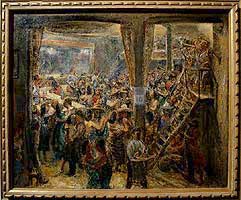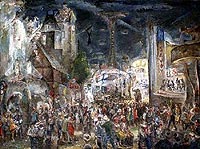
|
P R E S S > A R I C H L I F E O F P A I N T I N G
A Rich Life of Painting By Ann Holmes A gracious, sandy-haired woman met me at the door to the bungalow at 1841 Portsmouth. Inside, in room after room, were the paintings of Ary Stillman, hung as if in a museum. The lady is the widow of the late internationally known artist who had lived in Houston on and off before his death 13 months ago. This was the home they shared. Now it is a small permanent, one-man show of a museum type, open to the public every Sunday afternoon from 2 to 5 p.m. without admission charge. Or at any time, by appointment JA 8-2229. This is a warming collection and well worth a special trip. Stillman had the luck to live in the great epoch of painting and to work in the hot furnace of it all. He was born in a tiny village in White Russia in 1891, and went to school there. His early artistic talents appeared quickly and a small collection was taken up to send him to art school. So, by his mid teens, he was ensconced at the Imperial Art School at Vilna in Russia. When his parents left Russia in a tide of unrest to settle in Sioux City, Iowa, young Ary became an American. He had to go to work and spent long hours in a jewelry store. But painting he never gave up and he sought hours on the side to practice. Growing older, he knew what he wanted, only to paint, and so exposed himself to the teachings and ideas of his time. He enrolled at the Chicago Art Institute, later at The Art Students League, and the Jewish Educational Alliance in New York. But in the magic '20s, Paris was the word – the place – that quickened the heart in artists and writers. Ary Stillman went there, managed to have his own atelier, toured Europe, soaked up inspiration from old masters and met in the cafes, with the new artists. Art Stillman was deeply moved by what he called "the spiritual force that emanates from the old masters," as he wrote in 1934. All the while he was being moved and excited by the new work of the Paris of the great years, Stillman clung to his belief that "the greatest factor which evolves from continuous close contact with great works of art is that our vision is purified. We get to be less conscious of the vulgarity of things. Even the ugly becomes surrounded by a certain charm. My efforts have been…to discover an approach of my own in the light of the best that has gone before." Fortunately this artist who lived rich, working years in Europe, Mexico, New York – and finally Houston – kept representative works of all his styles and periods. In room after room of the house are pictures and drawings reflecting an artistic journey of a sensitive man, a skilled artist through a lifetime of maturing philosophy and en epoch wild with ideas and change. It would be a disservice to seek similitude between Ary Stillman, an artist in his own right, and famed modern masters. His exceptional watercolor sketch of a Polish Jew is an example of the immediacy and virtuosity of his essential craft. It is done with delicacy here, boldness there, and carries a mood and great clarity of Idea. A true gem, from 1925. "In the Studio" a nude, academic type painting, is nevertheless a moody textural work, reflecting the new paint techniques, to say nothing of the popularity as shown by Matisse, and others, for luscious odalisques. Nothing in his total oeuvre is more appealing than "The Kitchen" of 1932, a typical large cooking room in a French house with a woman standing over the stove, a cat nearby. It is infused with light, an Impressionist work. His "El Salon Mejico" is one of those genre pictures – masses of people crowded into a night club, dancing; brawling, for him "a study in the relationship of realities – people, moving crowds, play of light. "Copland wrote a piece of music in 1936, four years earlier, called "Salon Mexico." It is obviously a theme for artists. Typically Stillman chose to avoid the play of vivid color, dealing instead with the moving design. He composed a number of choice landscapes in muted tones, slightly impressionist in technique; and probably during his period of work with Andre Lhote, he veered into the geometric patterns like those of "Section d'Or" an offshoot of cubism. His drawings are in no way less important than the pictures. They have sensitivity and, I suspect, are deeply reflective. In his later years, forever young in spirit as his niece, Fredell Lack, has recalled, he was wide awake to abstract techniques while still revering the older masters. And in Mexico, he let his canvases leap alive with color as he employed some of the ancient archaeological myths ideas, and ritualistic decorations.
But if you go to see the collection, look for "World’s Fair," it's one of his most famous, and is full of some of the lyric and festival spirit of Delaunay and Chagall. There is a fine catalogue available with meaningful introduction by James Chillman Jr., Director Emeritus of the Museum of Fine Arts. The collection is on public view through the efforts of the Stillman-Lack Foundation as the artist had wished.
|
| © 2008 The Stillman-Lack Foundation, All text and images on this site may not be published, broadcast, or distributed in any form without the prior written permission of The Stillman-Lack Foundation. |


